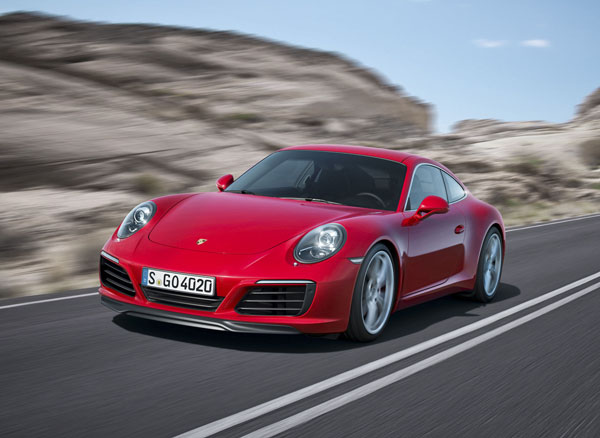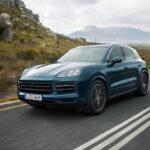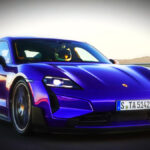Porsche 911 has just been announced and the biggest change is the introduction of turbocharged engines in all models. This hardly comes as a surprise as the other German marques have all been gradually switching to turbo units to meet ever tightening emission regulations.
At the same time the iconic shape of Porsche 911 has been given a mild revamp for 2016, and Porsche Communication Management (PCM) system has been upgraded.
Though instantly recognisable as a Porsche 911 the Carrera has been visually modified. New headlights, with four-point daytime running lights, door handles without recess covers, a redesigned rear cover with vertical louvres and new rear lights with four-point brake lights.
Porsche is no stranger to turbocharging as Turbo models – with a capital ‘T’ – have been around for decades, but always in the high-performance, ultra-high-performance and racing cars. The Porsche 919’s position at the top spot on the podium of this year’s Le Mans 24-hour classic underlines this fact.
The engineers have drawn on many decades of experience with turbo engines to come up with the new engines in the MY2016 911 Carreras. The new engine generation is, naturally, a flat-six and uses bi-turbo units. With a substantial capacity (for turbos) of 3.0 litres the engines provides 272 kW (370 hp) of power in the 911 Carrera.
Carrera S delivers 309 kW (420 hp) thanks to the use of modified turbos, a specific exhaust system and more highly tuned engine management system.
The biggest advantages of using turbos from the point of view of driving performance is the big torque numbers they provide and the fact that the torque is there from very low revs.
So the new engines’ torque figures are both up by 60 Nm compared to the outgoing units. Maximum torque is 450 Nm for the Carrera and 500 Nm for the Carrera S. The torque plateau arrives at a low 1700 rpm in both engines, and is there all the way up to 5000 revs.
The downside of turbo engines is that they often have slower throttle response than naturally aspirated engines. Obviously the longtime experience of Porsche engineers in this field will be an advantage and we look forward checking out the results when we get to drive the new Carreras next year.
The new-gen engines are almost 12 percent more efficient than the about to be superseded units. Porsche 911 Carrera with PDK transmission now uses just 7.4 litres per hundred kilometres on official testing (a reduction of 0.8 litres per hundred); the 911 Carrera S with PDK registers at 7.7 litres per hundred kilometres down (1.0 litres per hundred kilometres).
More importantly for the sporting driver, the new engine in the 911 Carrera Coupe with PDK and the Sport Chrono Package sprints from zero to 100 km/h in 4.2 seconds – two tenths of a second faster than its predecessor. The 911 Carrera S Coupe gets that time down to 3.9 seconds.
Porsche 911 Carrera now has a top speed of 295 km/h (up by six km/h). Carrera S now reaches 308 km/h (four km/h more than previously).
When the optional Sport Chrono Package is installed the 911 Carrera has a Mode switch on the steering wheel. It has a four-position rotary dial that selects Normal, Sport, Sport Plus – and Individual if you want to experiment with your own setup.
Depending on the equipment fitted to the 911, the Individual setting lets drivers configure the PASM, active engine mounts, PDK shifting strategy and sports exhaust system.
If the PDK double-clutch auto is specified the Mode setting has an additional Sport Response Button. When this button is pressed the drivetrain is pre-conditioned for maximum acceleration for 20 seconds. The best gear is engaged and the engine management adjusted to an even more spontaneous response for a short time.
PASM chassis (Porsche Active Suspension Management), which lowers the ride height by 10 mm, is standard on all new Carrera models.
Wheels with five twin spokes carry tyres with reduced rolling resistance as well as enhanced performance. The width of the rear rims has increased by 0.5 to 11.5 inches and the rear tyres of the 911 Carrera S now measure 305 instead of 295 mm.
Active rear-axle steering is available as an option for the 911 Carrera S. Porsche advises the chassis technology is adopted from the 911 Turbo and 911 GT3.
A standard feature of the new 911 Carrera models is the newly developed Porsche Communication Management System (PCM) including voice control. The PCM can also be operated by performing multi-touch gestures on the seven-inch display, similar to operating a smartphone. User inputs by handwriting are also possible.
Infotainment is via a heavily upgraded Porsche Communication Management system with a multi-touch display that has an expanded range of functions, and which Porsche assures us is greatly simplified in its operation. We’ve yet to drive the car so can’t comment on the latter.
Though mobile phones and smartphones can now also be connected via Wi-Fi in some countries, they can only be connected via Bluetooth or USB on new 911 models sold in Australia. This means new Google Earth and Google Street-view navigation functions will be delayed until later in 2017 when a new LTE telephone module is certified for Australia. The new Porsche Connect app also gets delayed until the necessary back-end systems are in place early in 2018.
A smartphone tray is now in the centre armrest and offers battery charging and optimised phone reception. Also new is the option of connecting an iPhone to the PCM to use Apple CarPlay.
We won’t see the new Porsche 911 Carrera models in Australia unit March 2016, but be assured that dealers will be happy to speak to potential buyers now.
Prices are:
911 Carrera Coupe: $217,800
911 Carrera S Coupe: $252,800
911 Carrera Cabriolet: $239,300
911 Carrera S Cabriolet: $274,300
Note: These prices do not include dealer or government charges. Contact your local Porsche dealer for drive-away prices.













